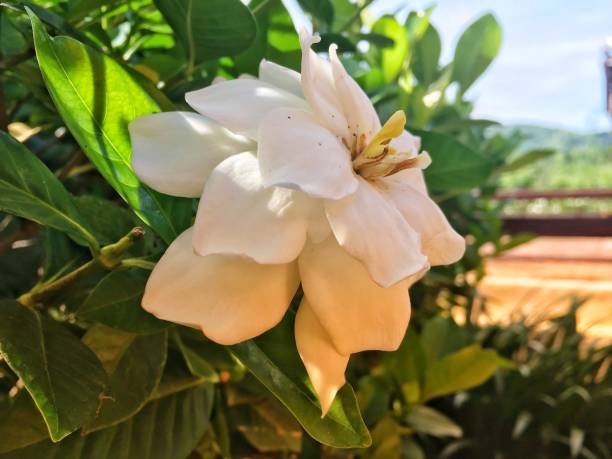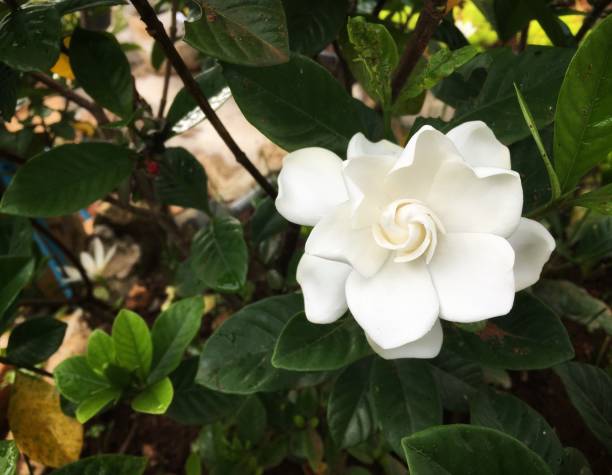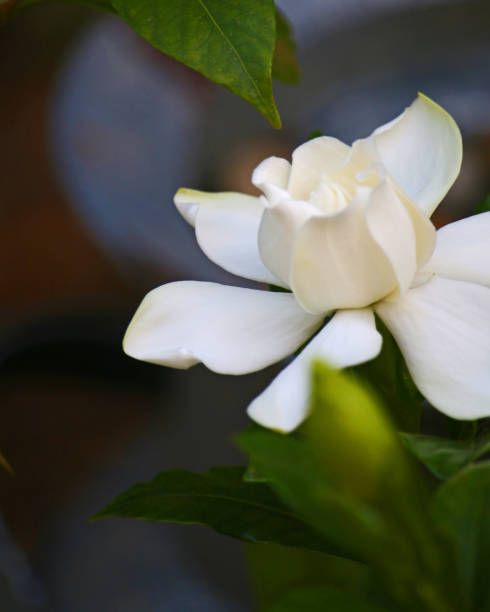How To Keep Gardenia Alive
Gardenias are a beautiful addition to any garden, but they can be a little tricky to keep alive. This blog post will outline how to keep your Gardenia alive and healthy.

Table of Contents
Only Water Your Gardenia if the Soil is Dry
Some people tend to overwater their plants as they always do it every day. Here is the rule. Water the plant only when the soil is dry. Always check before watering. To test the soil, stick your finger about two inches deep. If the soil around your Gardenia still feels damp, it’s not time to water it yet. However, if it’s dry, water it at least an inch. Water drains out of the drainage holes in their bottoms for potted Gardenias. It should be done every 2 to 3 weeks or until the soil is parched. If you allow it to become drought-stressed, you may notice that your Gardenia begins to lose its blooms and flowers.
If you water them instead of tap water with rainwater, your plant will surely love it. Rainwater contains many nutrients, especially nitrates and nitrites necessary for plants’ growth.
Provide Gardenia with Their Preferred Soil
When growing gardenias, stay away from heavy, alkaline clay with poor drainage and coarse, sandy soils. The ideal mixes consist of equal parts fibrous loam, peat moss, and well-decaying manure, or one-part loam, one-part leafmold, and one-part well-decaying manure depending on the situation. Make a hole about 12 inches deep and two feet wide in loam or sandy soil, and fill it with a mixture of the two soil types. Alternatively, if the soil is heavy clay, dig a larger hole and mix coarse sand with the previously mentioned combination. Some gardeners believe that we should dig a 3-foot-deep trench in rich clay soils and fill the bottom foot with gravel to improve drainage and allow for more root growth. Gardenias have shallow roots, so avoid gardening around the root zone once they have established themselves.
Gardenias require acidic soil to flourish. The soil’s pH level should be in the range of 4.5 to 6.0. High alkaline soil will cause your Gardenia’s leaves to be yellow and fall off, and it will almost certainly fail to bloom. The pH level of the ground naturally changes due to the watering and fertilizing of the plants. Use a soil pH test kit to regularly assess the soil’s condition. To increase the soil’s acidity, you should water your Gardenia with diluted vinegar or tea leaves once a month. Organic coffee grounds are also great. Gardenias grown in alkaline soil are prone to chlorosis (yellowing of the leaves) and flowering failure, which can be fatal.

Make Sure Your Gardenia Gets the Sunlight It Needs
It is recommended that gardenias be planted in the shade, preferably out of direct sunlight in the afternoon. Gardenias thrive in hot climates with plenty of early morning sun and afternoon shade. Their roots may be protected by organic mulch in milder temperatures, allowing them to take advantage of all available light. To achieve the best results, gardenias in pots should be placed in bright sunlight or filtered shade, away from direct sunlight. Gardenias grow with long thin leaves when exposed to too much shade. The number of flower buds produced is lower, and those that do form may fall off before they have a chance to open. Gardenia flowers exposed to too much sunlight wilt more quickly than those exposed to some shade.
Maintain As Much Warm Temperature As Possible for Your Gardenia
Gardenias should be grown indoors at temperatures ranging from 65-70° F(18.3 -21.2 ° C) during the day and 55 -65° F (12.8 -18.3°C) at night. If the temperature rises above 70° F (21.2° C), the buds on the plant may begin to fall off. Gardenias thrive in temperatures that are comfortable for people during the daytime. Keep in mind to bring them inside when the weather begins to cool. Place your plant where air can easily circulate around them. Maintain the safety of your plant by ensuring that it is free of drafts. When exposed to cooler evening temperatures, plants have a greater chance of setting flowering buds. Preventing sudden temperature drops is important because they can cause leaves and flowers to fall off.
Fertilize Your Gardenia Plant
Plants grown in bright, warm conditions are notoriously heavy feeders. Gardenias are no exception when grown in bright, warm conditions. You can feed them to your plants once a week by diluting a 1/4 teaspoon solution of 15-15-15 (Nitrogen, Potassium, Phosphorus) fertilizer in 1 gallon of water and applying it to the plants. Plants in your garden should be fertilized with acid fertilizer twice a year, around the middle of March and the end of June.
Use an acidifying fertilizer (such as azalea fertilizer) in the spring. After the cold winter has passed, feeding them in four seasoned regions in mid-summer and late June will ensure that the Gardenias bloom in autumn. If you plan to leave to overwinter your Gardenia outside, don’t fertilize them in the fall because new growth may be damaged if temperatures fall below 15°F. On Late summer, stop feeding to give new growth enough time to harden off before the cold season arrives.
Due to the common problem of yellowing leaves, use a fertilizer containing both iron and magnesium.
Fertilize outdoor container plants with an acidifying fertilizer every three weeks to keep them healthy.

Maintain a High Level of Humidity of Your Gardenia
Gardenias thrive in and require humidity in the range of 50 percent to 60 percent. Most homes, on the other hand, only have dry air. There are numerous methods for increasing and maintaining the humidity level indoors.
Every day, give your Gardenia a light misting. Spray your Gardenia with water, or you can use a humidifier to add moisture to the dry indoor air by placing it in the room. It is best not to mist directly onto the buds or blooms as this may cause them to discolor.
Plants should be placed close together. The same as misting, it is also an effective method of raising or maintaining humidity levels.
Place the potted plant on a saucer. You can also use a drainage dish filled with gravel or pea pebbles to a depth of about an inch and water as needed. Fill the dish halfway with water, completely submerging the pebbles. Invert the potted Gardenia on top of the gravel, ensuring that the water does not reach the bottom of the plant container. It is necessary to replenish the water on a regular basis because it evaporates. Humidity levels should range from mild to tropical depending on the season.
A layer of organic mulch is also beneficial to Gardenias. Simply place a layer of organic mulch on top of the potting soil to achieve the desired effect. This is an excellent method of keeping the roots moist without drowning them. Mulch can also help to raise the humidity levels in the air.
Leave a bowl filled with a white string that has been dampened and threaded through the lid. It will keep your indoor air naturally exchanging moisture because it evaporates more readily in humid conditions than it does in dry conditions. During the winter heating season, when humidity is less likely to rise, drape potted gardenias with towels to prevent evaporation loss from cut stems from occurring.
While gardenias thrive in humid air, it is critical to maintaining control over the humidity level. Fungal growth on the leaves is caused by an excessive amount of moisture. It will help dry the plant by circulating air around it, preventing moisture from accumulating on the leaves. Because of the use of central heating during the winter season, the humidity level decreases. A daily misting of two to three times per day can be beneficial. Before misting the leaves a second time, check to see that they are completely wet.
Keep Your Gardenia Away From Pests and Diseases
Pests like spider mites, scales, and aphids may choose to make their homes on the leaves, so they are inspected frequently. It is suggested that you use an antifungal-antipest product regularly to address all of these issues, but only in moderation to avoid further harming the plant. Insecticidal soap should not be used on gardenias because it may harm them.
If you want to keep the humidity level down and prevent the growth of fungus, you’ll need to space out your gardenia plants a bit. To stop the disease from spreading, remove any diseased parts of the plant and dispose of them. Avoid using fungicides if at all possible. Powdery mildew and other fungi should be treated immediately, and fungicides can help.
A gardenia’s stem canker is another potential issue. This disease frequently manifests as dark lesions with raised edges. Removing the infected stems with disinfected pruning tools can save your Gardenia from this disease. A ten percent chlorine bleach solution can be used to accomplish this. Afterward, you should irrigate the plant so that the soil is less saturated. Changing the plant’s watering and fertilizing schedules too frequently can cause stress.
